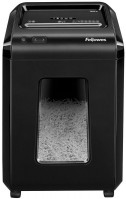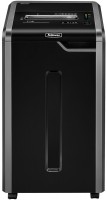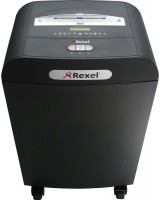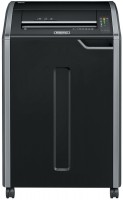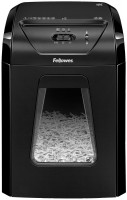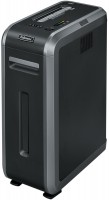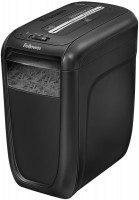Shredders Fellowes
All Shredders Advanced filters → |
You might be interested in
Shredders: specifications, types
Security level (DIN 66399)
Shredder security level according to DIN 66399. For its designation, the letter P (from Paper) and a number from 1 to 7 are used.
This indicator determines how well the destruction is carried out, how difficult it will be to recover a document or media passed through the device. The DIN 66399 standard provides seven security levels with the simplest numbering from the lowest to the highest: P-1, P-2, P-3, P-4, P-5, P-6, P-7. These levels apply to both paper and other media, however, shredders are used primarily for paper documents, this option will be discussed here; see "Shred items" for similar information on other materials.
— P-1. The paper is cut into stripes with a width of less than 12 mm or into pieces with an area of up to 2000 mm². A basic level that allows you to easily restore a destroyed document; designed for the utilization of documents that do not contain classified information.
— P-2. The paper is cut into stripes less than 6 mm wide or into pieces up to 800 mm². From a practical point of view, it has no fundamental differences from level P1 — except that the shredder waste bin fills up not so quickly due to the smaller size of the fragments.
— P-3. The paper is cut into stripes...with a width of less than 2 mm or into fragments with an area of up to 320 mm². It is impossible to restore a document destroyed in this way manually, although this can be done using special technical equipment.
— P-4. The paper is cut into pieces with a width of less than 6 mm and an area of less than 160 mm². This level is considered perhaps the most optimal for "considerate" materials, which do not require the maximum security levels — for example, everyday business documents like financial statements. Recovery from level P4 processing is extremely difficult even with special equipment (although possible), while the shredders themselves are relatively simple and inexpensive. In addition, they can easily provide destroying paper clips and staples.
— P-5. The paper is cut into pieces with a width of less than 2 mm and an area of less than 30 mm². This level is ready for business documents of strategic importance, such as long-term plans.
— P-6. The paper is cut into pieces with a width of less than 1 mm and an area of less than 10 mm². After such processing, the restoration of the document becomes almost impossible.
— P-7. The maximum level of security: the paper is cut into pieces with a width of less than 1 mm and an area of less than 5 mm². Such shredders are very expensive, and besides, they do not have much performant. Therefore, it makes sense to use them for documents of special national importance and other materials of similar importance.
It is also worth noting that the security level affects the speed of filling the shredder waste bin. The smaller the pieces of paper, the denser they fit into the basket and more time it takes to fill it with the same volume.
This indicator determines how well the destruction is carried out, how difficult it will be to recover a document or media passed through the device. The DIN 66399 standard provides seven security levels with the simplest numbering from the lowest to the highest: P-1, P-2, P-3, P-4, P-5, P-6, P-7. These levels apply to both paper and other media, however, shredders are used primarily for paper documents, this option will be discussed here; see "Shred items" for similar information on other materials.
— P-1. The paper is cut into stripes with a width of less than 12 mm or into pieces with an area of up to 2000 mm². A basic level that allows you to easily restore a destroyed document; designed for the utilization of documents that do not contain classified information.
— P-2. The paper is cut into stripes less than 6 mm wide or into pieces up to 800 mm². From a practical point of view, it has no fundamental differences from level P1 — except that the shredder waste bin fills up not so quickly due to the smaller size of the fragments.
— P-3. The paper is cut into stripes...with a width of less than 2 mm or into fragments with an area of up to 320 mm². It is impossible to restore a document destroyed in this way manually, although this can be done using special technical equipment.
— P-4. The paper is cut into pieces with a width of less than 6 mm and an area of less than 160 mm². This level is considered perhaps the most optimal for "considerate" materials, which do not require the maximum security levels — for example, everyday business documents like financial statements. Recovery from level P4 processing is extremely difficult even with special equipment (although possible), while the shredders themselves are relatively simple and inexpensive. In addition, they can easily provide destroying paper clips and staples.
— P-5. The paper is cut into pieces with a width of less than 2 mm and an area of less than 30 mm². This level is ready for business documents of strategic importance, such as long-term plans.
— P-6. The paper is cut into pieces with a width of less than 1 mm and an area of less than 10 mm². After such processing, the restoration of the document becomes almost impossible.
— P-7. The maximum level of security: the paper is cut into pieces with a width of less than 1 mm and an area of less than 5 mm². Such shredders are very expensive, and besides, they do not have much performant. Therefore, it makes sense to use them for documents of special national importance and other materials of similar importance.
It is also worth noting that the security level affects the speed of filling the shredder waste bin. The smaller the pieces of paper, the denser they fit into the basket and more time it takes to fill it with the same volume.
Shredding Items
Types of media and materials that the shredder can utilize. Note that, by definition, all such devices are capable of working with paper documents, so paper is not mentioned in this paragraph (some models are generally only compatible with paper and do not allow using other materials). However, shredders with the ability to utilize various additional items are more common — mainly staplers, paper clips, credit cards and/or CDs/DVDs. Here are the features of each of these options:
— Staples. An auxiliary function designed to ensure that stapled materials do not have to be separated before being loaded into the shredder. Allows you to significantly save time when utilizing of such materials, especially in large volumes; also provides a correct operation guarantee in case of accidental contact with the staples.
— Paper clips. Paper clips are removed much easier than staplers and there is no problem with them even with a large amount of documents. Therefore, this function is rather an insurance against getting such a clip into the device along with the document.
— Credit cards. The ability to recycle various plastic cards with magnetic media — credit cards, passes, etc. This feature at least prevents the illegal use of such cards, and with a high security level it allows you to...keep the fact of the existence of a card in secret. Actually, the security level for such utilization is indicated in the generally accepted standard DIN 66399, as like as for paper, and there are seven of them:
— Staples. An auxiliary function designed to ensure that stapled materials do not have to be separated before being loaded into the shredder. Allows you to significantly save time when utilizing of such materials, especially in large volumes; also provides a correct operation guarantee in case of accidental contact with the staples.
— Paper clips. Paper clips are removed much easier than staplers and there is no problem with them even with a large amount of documents. Therefore, this function is rather an insurance against getting such a clip into the device along with the document.
— Credit cards. The ability to recycle various plastic cards with magnetic media — credit cards, passes, etc. This feature at least prevents the illegal use of such cards, and with a high security level it allows you to...keep the fact of the existence of a card in secret. Actually, the security level for such utilization is indicated in the generally accepted standard DIN 66399, as like as for paper, and there are seven of them:
- 1 — the card remains intact, its surface is mechanically damaged;
- 2 — the card is cut into pieces with an area of less than 2000 mm²;
- 3 — size of pieces less than 320 mm²;
- 4 — less than 160 mm²;
- 5 — less than 30 mm²;
- 6 — less than 10 mm²;
- 7 — less than 2.5 mm².
- 1 — the disk is cut into pieces with an area of less than 2000 mm²;
- 2 — less than 800 mm²;
- 3 — less than 160 mm²
- 4 — less than 30 mm²;
- 5 — less than 10 mm²;
- 6 — less than 5 mm²;
- 7 — less than 0.2 mm².
Cut Style
Way the shredder's knives move during the operation.
- Stripe cut. Alternative names "straight" or "lengthwise" are also met. This type models have one row of knives, and during operation they cut the material into stripes. The rate of protection against recovery (reliability of information destruction) is somewhat lower than in shredders with cross-cutting, however, stripe cutting provides significantly higher speed and productivity. Therefore, such models are recommended primarily for cases where the ability to work with large volumes of materials is most important.
- Cross-cut. For cross-cutting two rows of knives are used, which are arranged at an angle to each other; due to this, the shredded material is not cut into stripes, but into separate pieces of a certain size, depending on the security level (see above). In general, the rate of security is much higher than stripe cutting, and if safety and reliability of destruction are the most important, so you should pay attention to such models. The other advantage is that small pieces ensure that the waste bin is filled more densely, and it will have to be emptied much less frequently. Cons that worth noting are the relatively low speed and higher cost rate.
- Stripe cut. Alternative names "straight" or "lengthwise" are also met. This type models have one row of knives, and during operation they cut the material into stripes. The rate of protection against recovery (reliability of information destruction) is somewhat lower than in shredders with cross-cutting, however, stripe cutting provides significantly higher speed and productivity. Therefore, such models are recommended primarily for cases where the ability to work with large volumes of materials is most important.
- Cross-cut. For cross-cutting two rows of knives are used, which are arranged at an angle to each other; due to this, the shredded material is not cut into stripes, but into separate pieces of a certain size, depending on the security level (see above). In general, the rate of security is much higher than stripe cutting, and if safety and reliability of destruction are the most important, so you should pay attention to such models. The other advantage is that small pieces ensure that the waste bin is filled more densely, and it will have to be emptied much less frequently. Cons that worth noting are the relatively low speed and higher cost rate.
Fragment sizes
The largest possible size of the fragments that come out from the shredder after being processed. However, it's told about fragments only in the case of using cross-cutting; for stripe cut models (see “Cut Style”), this item indicates the largest width of the stripes. The size of the fragments is directly related to the security level provided by the shredder; see the relevant paragraph above for details.
Gap Size
The gap size of the shredder is the opening where the utilization materials are placed. This indicator determines the maximum size of the material that the device can handle at one time, without the need to fold or cut the sheet. The common gap size for most office models is 220 – 230 mm — this allows you to easily work with the popular A4 format(sheet width — 210 mm). But for sheet A3, with a width of 297 mm, you will need at least 310 mm gap size.
Shredding speed
The speed that processed unit moves through the shredding mechanism during utilization. Accordingly, the higher this indicator, the higher the productivity of the shredder and the more units it is able to shred in a certain time. Knowing the volume of the documents to be shredded, you can easily determine the time required for batch utilization: for example, with a speed of 45 mm/s, one load of standard A4 sheets (length 297 mm) will require 297/45=6.6 s.
However, it should be taken into account that this parameter is usually indicated for paper of a certain density — 80 g/m² (standard office paper) or even 70 g/m², depending on the manufacturer. When working with thicker paper, as well as other materials (see "Shredding Items"), the shredding rate may be significantly lower than stated.
However, it should be taken into account that this parameter is usually indicated for paper of a certain density — 80 g/m² (standard office paper) or even 70 g/m², depending on the manufacturer. When working with thicker paper, as well as other materials (see "Shredding Items"), the shredding rate may be significantly lower than stated.
Sheets per load
The number of sheets that the shredder is capable of processing at one time — in other words, the largest size of a stack of sheets that can be loaded into the device. Most modern shredders can handle multiple sheets; up to 5 pcs at a time is considered a very limited indicator, up to 10 pcs — a small one, 11 – 15 pcs can be called an average value, 16 – 20 pcs — quite good, and in the most powerful models this figure exceeds 20 pcs.
Note that this parameter is given for paper of a certain grammage (and, accordingly, thickness). At the same time, the East European standard for office paper is a grammage of 80 g/m², and in many European countries thinner paper is used with a grammage of 70 g/m², and it is for it that the capacity of many shredders is indicated. Therefore, if this moment is not specified in the specs, it is best to load the shredder not up to limit values, making a margin of 1 sheet per 8 sheets of capacity — 1 sheet with a stack thickness of up to 8 sheets, 2 sheets with a stack thickness of 8 to 16 sheets, etc. However, other conditions for density may be specified in the user manual.
Also note that the number of sheets per load is determined by manufacturers based on the results of tests under perfect conditions — in the absence of staples on paper, with low humidity,...optimal voltage in the mains, perfect sharpening of knives, etc. In fact, any deviation from these indicators affect some decrease in efficiency.
Note that this parameter is given for paper of a certain grammage (and, accordingly, thickness). At the same time, the East European standard for office paper is a grammage of 80 g/m², and in many European countries thinner paper is used with a grammage of 70 g/m², and it is for it that the capacity of many shredders is indicated. Therefore, if this moment is not specified in the specs, it is best to load the shredder not up to limit values, making a margin of 1 sheet per 8 sheets of capacity — 1 sheet with a stack thickness of up to 8 sheets, 2 sheets with a stack thickness of 8 to 16 sheets, etc. However, other conditions for density may be specified in the user manual.
Also note that the number of sheets per load is determined by manufacturers based on the results of tests under perfect conditions — in the absence of staples on paper, with low humidity,...optimal voltage in the mains, perfect sharpening of knives, etc. In fact, any deviation from these indicators affect some decrease in efficiency.
Duty cycle
The duty cycle of the shredder is the maximum time that it can work without interruption.
Limit of operating time is due to the fact that the destruction of documents and other media is associated with quite significant loads on the electric motor and gear. This leads to strong heating, while the breaks allow the hardware of the shredder to cool down. Actually, there are models with the possibility of continuous operation, but they are expensive and not always really necessary; see "Features" for details.
In small shredders for domestic use, the work cycle is often only a few minutes, and among powerful professional devices there are values of half an hour or more. Also note that in some models, shutdown after a full cycle is provided automatically due to overheating protection (see "Features"), however, the presence of such a system does not mean the presence of an automatic shutdown on time — it can only work with a critical increase of temperature.
Limit of operating time is due to the fact that the destruction of documents and other media is associated with quite significant loads on the electric motor and gear. This leads to strong heating, while the breaks allow the hardware of the shredder to cool down. Actually, there are models with the possibility of continuous operation, but they are expensive and not always really necessary; see "Features" for details.
In small shredders for domestic use, the work cycle is often only a few minutes, and among powerful professional devices there are values of half an hour or more. Also note that in some models, shutdown after a full cycle is provided automatically due to overheating protection (see "Features"), however, the presence of such a system does not mean the presence of an automatic shutdown on time — it can only work with a critical increase of temperature.
Break time
The minimum break time required by the shredder after a full cycle of work (see above).
A break is required so that the motor and mechanisms of the device can cool down after the intense loads that they are subjected to during operation. Moreover, if the operating time was less than a full cycle, then the break can also be made shorter; however, if the device has worked for more than half of the cycle, for a full assurance it is still worth to take a break for all the time intended for it. Some models may provide other recommendations in this regard — they should be specified in user's manual.
A break is required so that the motor and mechanisms of the device can cool down after the intense loads that they are subjected to during operation. Moreover, if the operating time was less than a full cycle, then the break can also be made shorter; however, if the device has worked for more than half of the cycle, for a full assurance it is still worth to take a break for all the time intended for it. Some models may provide other recommendations in this regard — they should be specified in user's manual.
Daily Sheet Limit
The largest amount of sheets of paper that the shredder can shred in a day without overloading or other problems. Standardly indicated for A4 paper with a certain grammage; moreover, if this grammage is not given in the specs, it should be assumed that we are talking about paper with a grammage of 70 g/m², which is considered as the standard in many European countries. And since East European paperwork uses thicker paper — 80 g/m² — when choose a shredder depending on its daily sheet limit, it is worth taking a certain margin (at least 10 – 15%).
Note that even the simplest modern shredder can handle with the occasional shredding of documents (up to a couple of dozen sheets per day). Therefore, it is worth paying attention to this indicator mainly in cases where it is planned to shred the paper often and in large volumes. Also note that increasing the security level (see the relevant paragraph) reduces the reliability — more thorough shredding is associated with a higher workload on the mechanisms of the unit.
Note that even the simplest modern shredder can handle with the occasional shredding of documents (up to a couple of dozen sheets per day). Therefore, it is worth paying attention to this indicator mainly in cases where it is planned to shred the paper often and in large volumes. Also note that increasing the security level (see the relevant paragraph) reduces the reliability — more thorough shredding is associated with a higher workload on the mechanisms of the unit.
Sheet autofeed
The number of sheets of paper that can be loaded into the shredder's auto feed system at one time. Auto-feed greatly simplifies work with large volumes of documents: instead of loading them manually in portions and making sure that each portion size does not exceed the recommended value (for more details, see "Sheets per load"), it is enough to place the entire stack into the automatic feeder tray and the shredder will independently process the entire stack in the optimal mode.
Note that the number of sheets is often indicated for paper, which specs differ from those accepted in East European office work; see "Sheets per load" for details.
Note that the number of sheets is often indicated for paper, which specs differ from those accepted in East European office work; see "Sheets per load" for details.
Wastebin capacity
The volume of the waste bin that is filling with shredded materials after passing through the shredder. The larger it is, the less often you will have to empty the basket; at the same time, large containers increase both the weight and dimensions and the cost rate of the device. For comparison: the volume of a standard household bucket is about 10 liters, a shredder with a basket of such a capacity will have dimensions of about 35x30x15 cm and belongs to the entry level in terms of capacity.
Motor power
The power of the motor that drives the exterminator knives.
Engine specs are selected by manufacturers in such a way that the unit is guaranteed to be able to complete the tasks it's intended to. Therefore, while choosing the shredder this parameter has minor importance, the main attention should be paid to more lifelike specs — the sheets-per-load capacity, the speed of destruction, etc. However, devices of a similar degree of secrecy and price category may differ in power. In such cases, the difference is that a more powerful motor is capable of providing a thicker load stack, a faster shred rate, and/or a longer duty cycle (see above). The cons of these benefits are an increase in cost rate and energy consumption.
Regarding energy consumption, it is also worth noting that the motor power usually more or less corresponds to the total power consumption of the shredder. This data can be useful for some specific calculations — for example, calculating the total power of the load connected to an uninterruptible power supply.
Engine specs are selected by manufacturers in such a way that the unit is guaranteed to be able to complete the tasks it's intended to. Therefore, while choosing the shredder this parameter has minor importance, the main attention should be paid to more lifelike specs — the sheets-per-load capacity, the speed of destruction, etc. However, devices of a similar degree of secrecy and price category may differ in power. In such cases, the difference is that a more powerful motor is capable of providing a thicker load stack, a faster shred rate, and/or a longer duty cycle (see above). The cons of these benefits are an increase in cost rate and energy consumption.
Regarding energy consumption, it is also worth noting that the motor power usually more or less corresponds to the total power consumption of the shredder. This data can be useful for some specific calculations — for example, calculating the total power of the load connected to an uninterruptible power supply.
Features
— Auto start/stop. The system of automatic switching on and off of the shredder facilitates its use. To control the process in such models, you do not need to press buttons or perform any other additional actions: just place the processed material into the working gap and the shredder will start the utilizing process itself, and turn off automatically upon completion.
— Reverse. Possibility of rotation of knives of the shredder in reverse direction. This feature has several uses. One of the most obvious is to correct the situation when the knives are jammed (for example, if a stack of paper is too thick) or the mechanisms are clogged: by turning on the reverse, you can easily remove jammed materials from the working mechanism. Also, the reverse can be useful in cases where it was necessary to clarify something from an incompletely cut document. In addition, the disposal of plastic cards and optical discs (see “Destroys”) in most cases (although not necessarily) is carried out precisely in the reverse mode.
— Continuous work. This feature means that the shredder does not require interruptions in work and can utilize of a large amount of documents without any pauses (at least regarding daily duty cycle — see above). Such units are extremely convenient for large volumes of work, when the volume of a single portion of recyclable materials can be measured in thousands of sheets. On the othe...r hand, continuous operation requires very high reliability of the motor and gear, which significantly increases the cost. So it makes sense to specifically look for a model with the possibility of continuous operation only in cases where this function is fundamentally important.
— Overheat protection. A security system that automatically turns off the shredder's motor when its temperature increase to critical level (usually this happens during long work at high loads). This allows you to avoid unpleasant consequences — from the breakdown of the device to the open fire. Note that in some models, overheat protection plays the role of a circuit breaker that trips at the end of the work cycle (see above); in others, this function only works in abnormal situations, with a significant increase in temperature due to a serious malfunction.
— Bin full autostop. A sensor that monitors the fullness state of the basket and automatically turns off the device when it is full. Such a function not only eliminates the need to constantly monitor the fullness of the basket, but also prevents overloading due to the inability to push the next pack of materials into an overflowing waste bin.
— Reverse. Possibility of rotation of knives of the shredder in reverse direction. This feature has several uses. One of the most obvious is to correct the situation when the knives are jammed (for example, if a stack of paper is too thick) or the mechanisms are clogged: by turning on the reverse, you can easily remove jammed materials from the working mechanism. Also, the reverse can be useful in cases where it was necessary to clarify something from an incompletely cut document. In addition, the disposal of plastic cards and optical discs (see “Destroys”) in most cases (although not necessarily) is carried out precisely in the reverse mode.
— Continuous work. This feature means that the shredder does not require interruptions in work and can utilize of a large amount of documents without any pauses (at least regarding daily duty cycle — see above). Such units are extremely convenient for large volumes of work, when the volume of a single portion of recyclable materials can be measured in thousands of sheets. On the othe...r hand, continuous operation requires very high reliability of the motor and gear, which significantly increases the cost. So it makes sense to specifically look for a model with the possibility of continuous operation only in cases where this function is fundamentally important.
— Overheat protection. A security system that automatically turns off the shredder's motor when its temperature increase to critical level (usually this happens during long work at high loads). This allows you to avoid unpleasant consequences — from the breakdown of the device to the open fire. Note that in some models, overheat protection plays the role of a circuit breaker that trips at the end of the work cycle (see above); in others, this function only works in abnormal situations, with a significant increase in temperature due to a serious malfunction.
— Bin full autostop. A sensor that monitors the fullness state of the basket and automatically turns off the device when it is full. Such a function not only eliminates the need to constantly monitor the fullness of the basket, but also prevents overloading due to the inability to push the next pack of materials into an overflowing waste bin.
Display
Built-in display on the body of the device, designed to display various service information. Often this is the simple digital screen for 2 – 3 characters (perhaps, in addition with special icons). However, even a such kind of screen significantly improves usability, since it can display quite a variety of information: operating mode (forward/reverse), the daily limit left, error messages with error codes, etc. And in high-end shredders there are also more advanced displays — including a touch screen used for control also.
Transport rollers
Transport rollers are small wheels that also act as support. Such wheels make it much easier to move from place to place: one person can easily roll even a rather weighty unit that could not be lifted alone. And even with a small weight, rollers can also be very useful — for example, if the shredder is alternately used by several people in the same room it is easier to move the device to one of the tables for a while than to carry documents for recycling each time.
Transport wheels can be made removable; if necessary, this point should be clarified separately.
Transport wheels can be made removable; if necessary, this point should be clarified separately.
Noise level
The maximum noise level produced by the shredder during operation. The lower this indicator, the quieter the device works and the more comfortable it is to use, the better it is suitable for conditions that require silence (for example, libraries or archives).
When assessing the noise level, it should be taken into account that the decibel is a non-linear measure unit, and noises with a difference of several decibels differ in volume by several times. For comparison, we can proceed from the following data: office shredders, positioned by the manufacturer as "quiet", have a noise level of about 55 – 60 dB, which corresponds to the volume of ordinary human speech. 65 dB can be compared with a loud conversation, 70 – with a noisy street, 75 – with a scream, and there is practically no higher volume among office models.
When assessing the noise level, it should be taken into account that the decibel is a non-linear measure unit, and noises with a difference of several decibels differ in volume by several times. For comparison, we can proceed from the following data: office shredders, positioned by the manufacturer as "quiet", have a noise level of about 55 – 60 dB, which corresponds to the volume of ordinary human speech. 65 dB can be compared with a loud conversation, 70 – with a noisy street, 75 – with a scream, and there is practically no higher volume among office models.




